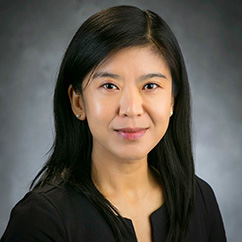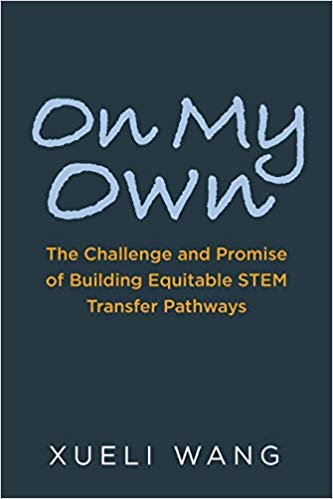UW-Madison’s Xueli Wang has spent much of her academic career examining ways to improve the higher education landscape in an effort to help college students find their path to a better life.
Wang’s research puts a particular emphasis on students who start out at two-year colleges with an eye on transferring to a four-year institution to earn a degree in a STEM (science, technology, engineering, or mathematics) field.

“There has been a lot of interest in expanding and diversifying STEM, and community and technical colleges are often portrayed as the engine to prepare STEM workers at the sub-baccalaureate level,” says Wang, a professor with the School of Education’s Department of Educational Leadership and Policy Analysis. “This narrative has troubled me as it leaves out a crucial function of many public, two-year institutions that enroll some of the most talented yet historically underserved students aspiring to transfer upward. These institutions and their transfer-aspiring students can no longer remain on the periphery of conversations of STEM bachelor’s degree attainment.”
More than eight million students enroll at community colleges across the United States, with 75 to 80 percent intending to transfer and earn a bachelor’s degree. Yet only about a quarter of those students actually transfer.
The students who do transfer, however, are highly successful and experience similar outcomes compared with students starting directly at four-year institutions.
But as Wang explains, the road to transfer is infiltrated with structural barriers. In addition, efforts to find new and more effective ways to support these highly motivated students on their academic journey weren’t being studied in a systematic and longitudinal way to fully uncover the various complexities and nuances related to transfer.
Until now.
With more than a decade of research in this realm, Wang is publishing her first book: “On My Own: The Challenge and Promise of Building Equitable STEM Transfer Pathways,” to be released by Harvard Education Press in March 2020.
Eboni Zamani-Gallaher, a professor of higher education and the executive director of the Council for the Study of Community Colleges, called Wang’s book, “one of the few texts that granularly captures the nuances of navigating hopes, dreams, and educational aspirations amid segmented opportunities and systemic inequities. It offers a sage call to action to those of us who want to enact transformative change and equitable student outcomes. All told, Wang has written a must-read primer for improving and diversifying STEM pathways.”
 Based on her longitudinal, mixed-methods research that was supported by the National Science Foundation (Grant No. DUE-1430642), the book follows 1,670 two-year college students over four years as they navigated STEM courses and programs in the Midwest. Wang brings to life students’ educational and life experiences as they traversed the prospect of transfer to a four-year institution.
Based on her longitudinal, mixed-methods research that was supported by the National Science Foundation (Grant No. DUE-1430642), the book follows 1,670 two-year college students over four years as they navigated STEM courses and programs in the Midwest. Wang brings to life students’ educational and life experiences as they traversed the prospect of transfer to a four-year institution.
“These students were very much on their own to navigate college and the transfer process without sufficient and consistent institutional support,” says Wang.
In her book, Wang describes how students ended up on one of four different pathways, or momentum trajectories: linear upward, detoured, deferred, or taking a break. These trajectories were shaped by preexisting and lasting disparities in students’ access to education and financial resources, their experiences with teaching and advising, and reconciling support from and for family.
“While community colleges hold great promise as a pathway to a bachelor’s degree in STEM, the current state of transfer has not yet evolved into a mechanism to alleviate inequities,” says Wang.
To cultivate a more equitable STEM transfer path, Wang’s book points out glaring systemic issues that need revisiting, including redesigning advising structures and fostering advising relationships that ensure students are both seen and heard. Also, college instructors and staff need to critically examine their own behaviors and actions. This means questioning and transforming classroom dynamics and interactions, taking a hard look at institutional data, and engaging in professional development and reflection to truly bring teaching and learning in STEM to the next level.
Davis Jenkins, a senior research scholar at the Community College Research Center of Teachers College, Columbia University, commented on how Wang remarkably “balances the tension between improving teaching and advising students at the interpersonal level and restructuring programs and services to change the experience for all students. (Wang) shows colleges must and can do both.”
“I hope this will be an informative read for researchers, practitioners, and policymakers alike, providing them with concrete and actionable steps toward change,” says Wang. “These students hold onto their high aspirations, show up every day despite some extraordinary odds and competing responsibilities. It’s our turn — for both transfer sending and transfer receiving institutions, and society writ large — to level the playing field.”
• Join the Wisconsin Center for the Advancement of Postsecondary Education (WISCAPE) and The Network on Tuesday, April 7 for a conversation with Wang to celebrate the launch of “On My Own.” The event, which includes lunch, runs from 12 to 1:30 p.m. in the Education Building’s Wisconsin Idea Room (room 159). Learn more about the book launch event.